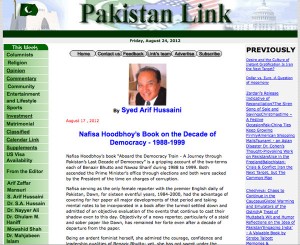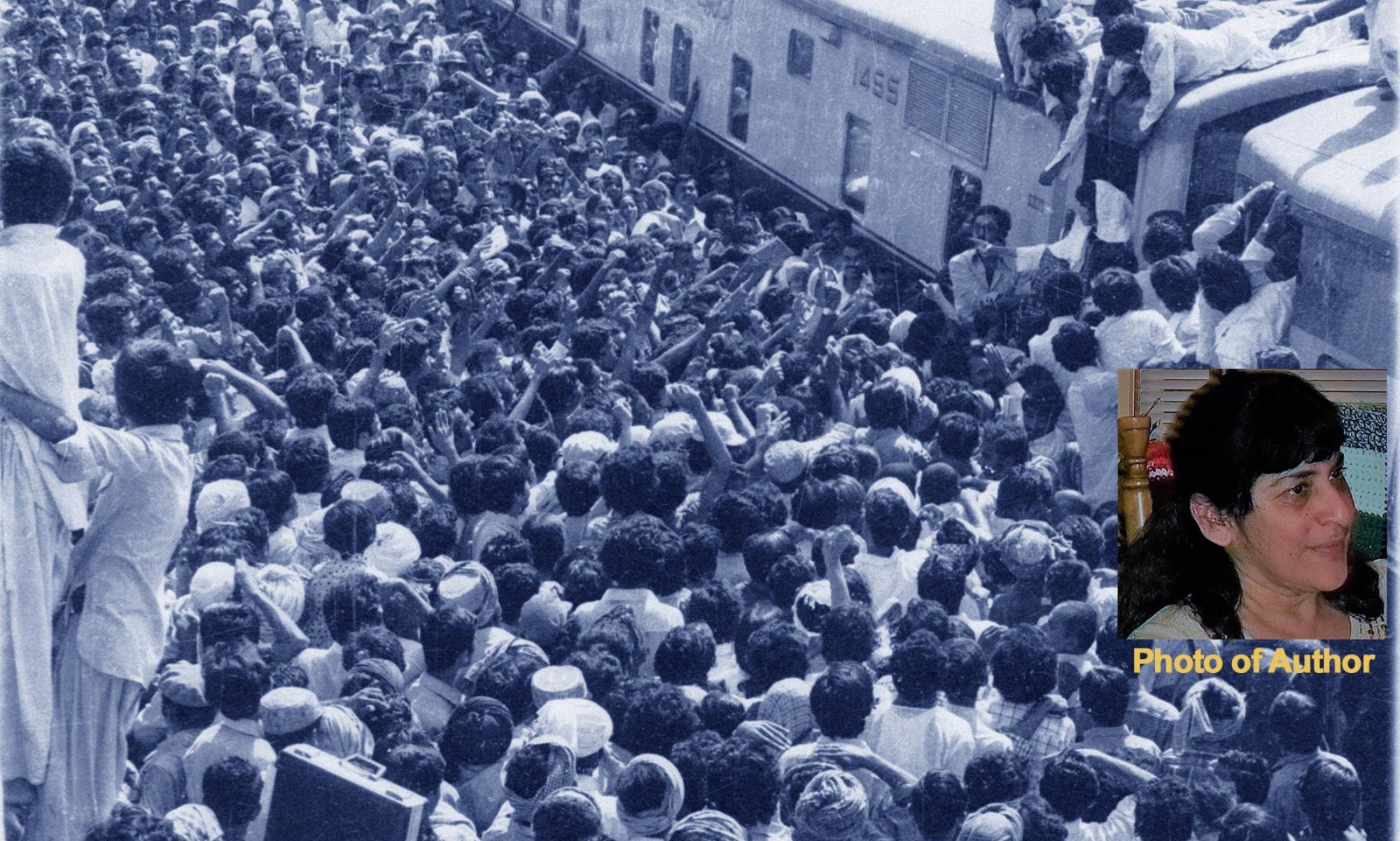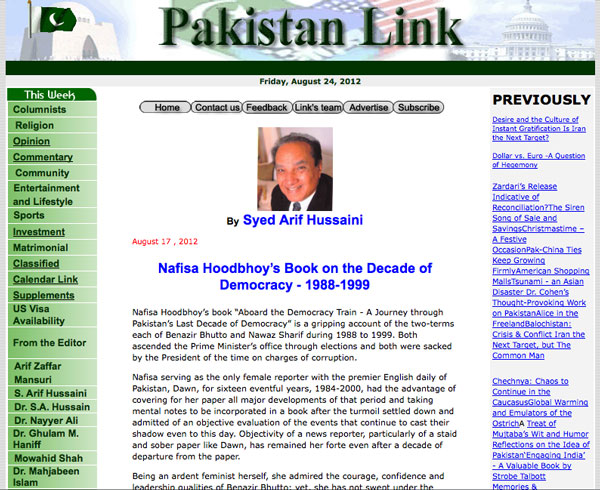
Nafisa Hoodbhoy’s book “Aboard the Democracy Train – A Journey through Pakistan’s Last Decade of Democracy” is a gripping account of the two-terms each of Benazir Bhutto and Nawaz Sharif during 1988 to 1999. Both ascended the Prime Minister’s office through elections and both were sacked by the President of the time on charges of corruption.
Nafisa serving as the only female reporter with the premier English daily of Pakistan, Dawn, for sixteen eventful years, 1984-2000, had the advantage of covering for her paper all major developments of that period and taking mental notes to be incorporated in a book after the turmoil settled down and admitted of an objective evaluation of the events that continue to cast their shadow even to this day. Objectivity of a news reporter, particularly of a staid and sober paper like Dawn, has remained her forte even after a decade of departure from the paper.
Being an ardent feminist herself, she admired the courage, confidence and leadership qualities of Benazir Bhutto; yet, she has not swept under the carpet Benazir’s arrogance, obstinacy and several other weaknesses. Nawaz Sharif has received scant attention of Nafisa despite the fact that he was one of the two PMs who ruled during the period covered by her. One may regard the book as a narrative of Benazir’s struggle to nurture the seedling of democracy she had planted in the country.
The author has revealed her unique experiences while covering the major shifts on the political landscape and her interest in uncovering the elements behind the ethnic violence in Karachi, the city of her birth, the gradual usurpation of women’s basic rights, freedom of the media, and the unfortunate travel of the society from a pluralistic and tolerant group to an ideologically driven, radical community intolerant of any change or progress. It has thus become a static, stagnant community.
By any measure, Nafisa’s book is a valuable addition to the existing literature on Pakistan. It is not a work of scholarship, like the books of Ayesha Jalal, but it is a worthwhile reference book on the events of the crucial period covered by it. Its outstanding feature is its frontline account by a person known for her objectivity in reporting. Her account is racy, piquant and riveting. The reader finds himself disinclined to put the book down till he has finished it. Being a repertoire of anecdotes and quotable quotes, it holds the attention of the reader till the very end – like a work of fiction.
Nafisa’s investigative reports on the notorious Sindh Chief Minister, Jam Sadiq Ali and the hordes of dacoits he patronized make interesting reading.
Nafisa is the younger sister of Dr. Pervez Hoodbhoy, the famous nuclear scientist who teaches at the Lahore University of Management Sciences (LUMS) and is known for his bold and forthright views often expressed through articles in leading Pakistani papers. She was born in an eminent Ismaili family of Karachi and after schooling at premier educational institutions of Pakistan, reached the US and got her master’s degree in history at an American university. On return to Karachi, she joined the widely read and prestigious English daily, Dawn, and served it as a reporter for 16 years. She is married and has lived in the US since 2,000. Aboard the Democracy Train is her first book in which she has tried to provide an insider view of the complex history and politics of her homeland. Based in the US after 2,000, she has used her vintage point to focus on American involvement in Afghanistan, its impact on Pakistan and the unique features of a war that seems to have no winners.
In her Introduction to the book, she has given highlights of her personal and family life in Karachi and the impact of the Western education on her thought process. “While the public space for women in Pakistan had shrunk, I had returned from the US with a greater taste for freedom.”
She has also mentioned how the coming into existence of Pakistan had brought waves after waves of Indian Muslim migrants to Karachi changing permanently the socio-cultural complexion of the sleepy town, turning it into a metropolis and the center of the commercial hustle and bustle of the newly formed state.
Nafisa’s distaste for military rule became more intense with Gen. Zia sending Bhutto to the gallows in a controversial case. And, her admiration for Benazir increased in a similar proportion once she wiped her tears over the “judicial murder” of her father and donned the mantel of a political gladiator to wrestle against the military might. The more her success in that direction, the more became the admiration of Nafisa for her. Her book thus strikes as a combination of the history of the tumultuous decade and an account of Benazir’s Herculean success in gaining access to power. “Seeing my enthusiasm for a woman Prime Minister, the editor of the newspaper bypassed senior male reporters and nominated me, the only female reporter of Dawn, to cover Benazir Bhutto.” She had thus to travel with Benazir on the Democracy Train through the desert of Sindh and witness the unprecedented welcome accorded to her by villagers who had walked for miles on foot to get a glimpse of the courageous daughter of their great leader Zulfikar Ali Bhutto.
During the rule of Jam Sadiq Ali, Chief Minister, Sindh was terrorized by gangs of dacoits said to be under the patronage of the Chief Minister. Nafisa, an unusually bold person, offered to do a story about them. Her visit to Matiari brought her in contact with people affected by Mohib Shidi in Matiari. She exposed the nexus between crime and politics in the province. The big landlords, Pir Pagara among them, were behind the dacoits while the small landowners, the main supporters of PPP, were punished in several ways for their support of PPP.
Covering the ethnic violence that erupted in Karachi in Aug-Sept, 1988, she discovered that the non-party election of Zia were at the root of the turmoil, since ethnicity became the binding factor in the absence of party affiliation. The MQM came into existence in 1985 shortly after Zia’s non-party elections.
She has given a vivid account of the threat of an attack on her by knife-wielding young men on September 23, 1991, within a day or so of the attack on Kamran Khan of the News, Karachi. That did in no way diminish her zeal to personally cover all such violent incidents and the mobilization of media protests against them.
A good portion of the book is devoted to the on-going struggle of enlightened women of Pakistan for their inalienable rights to freedoms denied to them on one pretext or another.
Nafisa Hoodbhoy has indeed produced a highly informative and readable book for Pakistanis at home and abroad.

